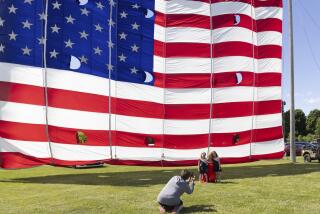A Woven Badge of Pride and History
- Share via
The U.S. flag is a potent symbol for America. The horrendous events of Sept. 11 made it a new badge of pride for many people who never considered themselves flag wavers.
From “Don’t Tread on Me” Revolutionary War banner to the photo of Marines raising Old Glory on Iwo Jima in 1945, the flag has been a rallying point for Americans during times of trouble and victory.
At the U.S. Flag Web site (www.usflag.org), we learn that one of the earliest American flag symbols was a segmented rattlesnake with the words “Join or Die.” The segments of the snake represented each colony, and the message was that disunity could be fatal.
The rattlesnake again appeared on the “Don’t Tread on Me” flags on the mid-1770s. The rattler was a popular symbol because it was uniquely American and was nonthreatening unless provoked--and then it could turn deadly. That message again rings true today.
In addition to the history of the flag, the site has information on Flag Day, patriotic writings and flag etiquette.
More formal rules of flag manners are at Dick Grogan’s Unofficial American Flag Page (www.treefort.org/~rgrogan/web/flaglaw.htm). The flag should never be used as apparel, by the way, and shouldn’t be flown at night unless it is illuminated.
A very succinct chronology of the flag is at Superflag (www.superflag.com/doc/history.htm). It starts with the red-and-white stripes of the Grand Union Flag in 1776, which was post-rattlesnake.
Dave’s American Flag Page (www.dave-ruffino.com/flags/national/USA_flags.html) doesn’t have a lot of info but does have good art of the evolution of the American flag.
To see what the flag looked like each time a new state entered the union, visit www.readingeagle.com/krt/holidays/flag1/flag.htm#. When California became a state in 1851, there were 31 stars, including one big one right in the middle of the blue field.
You can do a virtual tour of Betsy Ross’ house at www.ushistory.org/betsy/flaghome.html. Ross is believed to have sewn the first Stars and Stripes. Another woman who played an important role in the history of the flag was Mary Young Pickersgill, who made the “Star-Spangled Banner that flew over Fort McHenry during the War of 1812 and inspired Francis Scott Key to write the poem that became our National Anthem,” according to the Flag House museum in Baltimore. Her story can be found at www.flaghouse.org.
The flag Pickersgill created is at the Smithsonian National Museum of American History (americanhistory.si.edu/ssb). You can move your mouse over the image of the flag for quick bits of info or go deeper into the site and follow the investigative path of Smithsonian historians to learn about the flag’s past.
And while we’re in the Smithsonian’s neighborhood, the White House has a flag photo essay called “Standing for the Flag” up at www.whitehouse.gov/president/american-flag. The first photo is of firefighters planting the flag Sept. 12.
*
Robert Burns is an assistant Business editor at The Times.
More to Read
Sign up for The Wild
We’ll help you find the best places to hike, bike and run, as well as the perfect silent spots for meditation and yoga.
You may occasionally receive promotional content from the Los Angeles Times.






